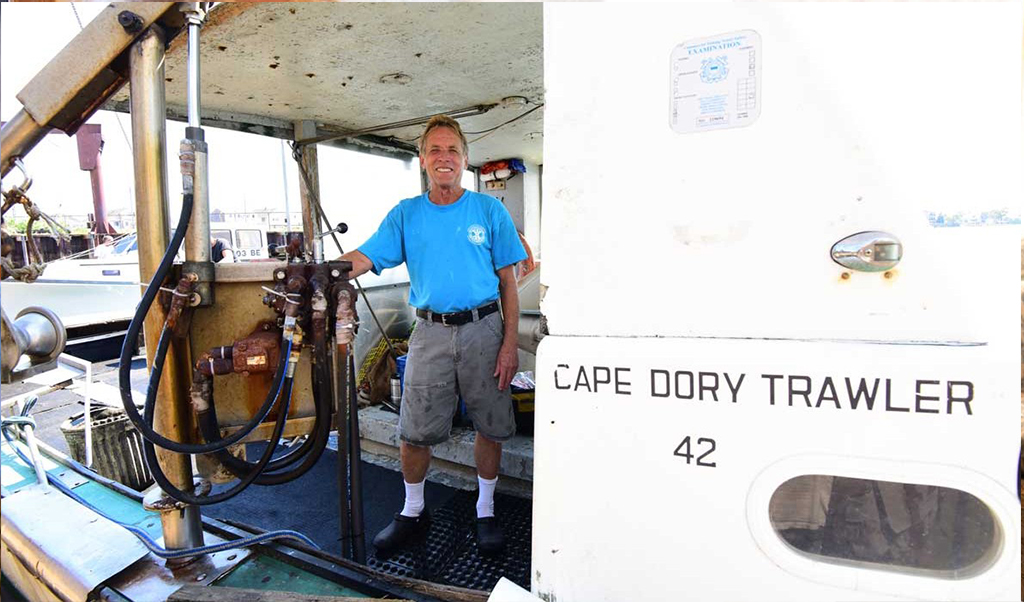As a lobsterman who’s spent six decades on the water, John Makowsky knows the meaning of lasting relationships—with the sea, with his boat, with his crew, and with his best friend of 16 years: a seagull named Red Eye.
Makowsky hails from Long Island Sound in Connecticut, where he grew up in the shadow of his father hauling traps in the early 1960s. He attended college in Vermont and dabbled in a variety of professional endeavors before returning to his roots as a fourth-generation fisherman, taking over the family business in the early 1980s.
In 1984, he had his dream boat built, a 42-foot Cape Dory trawler, F/V Intrepid, which he still uses to haul traps today. After the lobster die-off in Long Island Sound following Hurricane Floyd in 1999, Makowsky found himself working in an office in Massachusetts. He began adding federal permits to his boat and eventually made the jump to the New Hampshire Seacoast.
During his time on the water, Makowsky became aware of the differences in the seagulls that followed his boat.
“Most of them have their own character and individuality, besides physical things. If you have some awareness of the animals, you’ll notice different mannerisms: the way they move, the way they hop around, the way they land on the boat, the way they go after another, the way they avoid conflict or make conflict, the way they make their calls,” he said. “That’s the way I began to identify Red Eye.”
Red Eye, so named for a distinct coloring, began her tenure aboard Intrepid from the stern, where she would rotate between her go-to positions a safe distance from Makowsky.
“There’s been an increase in trust over the years. In the past, she was very camera shy. If I pulled my phone out to take a picture, she’d fly off. That was it. No pictures. Now she lets me take pictures,” said Makowsky.
“For a long time, she didn’t like me making eye contact with her. She’d turn away. Now she’ll just stand there and look right at me and I can talk to her,” he said.
The two friends are now so at ease with each other that Red Eye will eat brown hake—her favorite—from Makowsky’s hand. And quickly.
“Like today when I went out, I didn’t see any seagulls at all for five miles. All of a sudden in the sky, there was one flying toward me, and I knew it would be her. She always finds us,” Makowsky said.
He believes Red Eye spends the night on the Isle of Shoals.
“There have been times in the winter when I may drive offshore, 15-20 miles out, and I haven’t seen her. And all of a sudden, she’s there. When she wants to find me, she does.”
In June, Red Eye injured a foot, causing her to lose her balance on the offshore boat rides that she so loved.

“It was heartbreaking,” Makowsky said, and he began making calls, eventually finding the Center for Wildlife in Cape Neddick. After three weeks of attempting to wrangle Red Eye into captivity aboard the boat, Makowsky was finally successful in maneuvering his wounded companion into a lobster crate with a net and several bite marks to show for it.
“When I heard that a fisherman had brought in a gull, I was intrigued, because sometimes the gulls are seen as nuisance animals,” said Sarah Kern, community engagement specialist at the Center for Wildlife. “I didn’t realize that was just the tip of the iceberg. Red Eye truly has chosen Captain John as a companion.”
Despite a grim outlook in the early stages of treatment, Red Eye proved that a little comfort food can go a long way. Makowsky delivered her favorite brown hake, which boosted her spirits on the road to recovery.
Center for Wildlife staff members treated the older muscle and nerve damage that was restricting Red Eye’s use of her foot using a bootie designed to retrain the nerve and muscle, along with tub time for preening, waterproofing, and keeping weight off the feet and legs. Staff even turned to homeopathic remedies and reiki.
Within a few weeks, staff decided Red Eye was strong enough to heal in her natural element, with her friend by her side, and made arrangements with Makowsky to celebrate her release together at sea aboard Intrepid.
“The day on the boat solidified that she was right where she belonged,” Kern said. “Often when an animal is being prepared to be released, it’s stressful—lots of moving around, unfamiliar noises—they know something is up. The minute the boat started, Red Eye just sat down in the carrier next to John and waited. It was like she knew she was home.”
Makowsky saw the bird he knew return to form.
“She was so happy to be in the water, just like a playful child. She must have played in the water for ten minutes next to the boat,” he said. “Finally, she lifted up to fly off to Isle of Shoals.”
Since her release, Red Eye has come aboard every day.
“There’s a lot more intelligence than what we give them credit for,” Makowsky observed. “I can identify her as much as she can identify me from other people. There’s no doubt about that. She’s been on the boat longer than any person who’s ever worked with me.”





